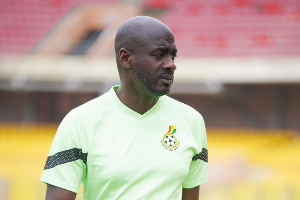Accra, July 9, GNA - Deputy Minister of Health, Mr Rojo Mettle-Nunoo, has advocated for innovative public education on the causes and treatment of Onchocerciasis.
He said this was necessary because of the re-emergence and problems associated with the disease in some communities in Ghana.
These are Bui Dam and Pru River areas in the Brong Ahafo Region.
Onchocerciasis, also known as River Blindness is a leading infectious cause of blindness.
It is caused by Onchocerca Volvulus, a nematode that can live up to 15 years in the human body though it can also live in other mammals.
Mr Mettle-Nunoo made the call at a meeting of experts conducting an independent evaluation of the African Programme for Onchocerciasis Control (APOC).
The experts are led by Dr Sam Adjei, Chief Executive Officer of Centre for Health and Social Services (CHeSS) in Ghana and others from the US, UK, Cameroon, Tanzania and Malaysia.
The three-day meeting, which includes field trips to endemic villages in the Eastern Region, is being supported by APOC Secretariat based in Burkina Faso.
In an interview with Ghana News Agency, Dr Adjei said there was the need to integrate oncho control with other programmes such as schistosomiasis (blood in urine), elephantiasis and Buruli Ulcer.
In addition, there is the need to strengthen health systems that have been fragmented to ensure a comprehensive and integrated health care.
Director of APOC, Uche Amazigo, indicated that it was important to empower communities through education to enable them to hold technocrats accountable for the success of health-related programmes.
She explained that such an achievement required time, dedication, commitment and urged all health providers and developmental NGOs and donors to exercise patience with the process of empowering communities.
Mrs Amazigo appealed to governments of affected countries to attend the donor ministers' meeting for Joint Action Forum (JAF) to make their voices heard and take ownership of Oncho programmes.
Giving an overview of the Oncho situation in Ghana, Programme Manager Nana Kwadwo Biritwum said Oncho control activities began in 1974 and was currently in a phased approach with financial and technical support from APOC.
He said several strategies aimed at different parts of the country were being employed using aerial larviciding and invermectin treatment which had improved reduction in the spread of the disease.
Improvement in the epidemiological situation has been seen in a recent mapping exercise conducted, he said, and added that therapeutic and geographical coverage had improved considerably.
Nana Biritwum said twice-a-year treatment was being implemented for problem areas that included communities within Pru area and Bui river basin while communities that required improved implementation were Northern, Volta, Eastern, Ashanti, Central and Western Regions.
He said these treatments were being supported financially and technically by Government of Ghana, APOC, Sight Savers Ghana, the endemic communities and drug donors Merck and Co and GSK through the Mectizan donation programme.
Health News of Friday, 9 July 2010
Source: GNA
















